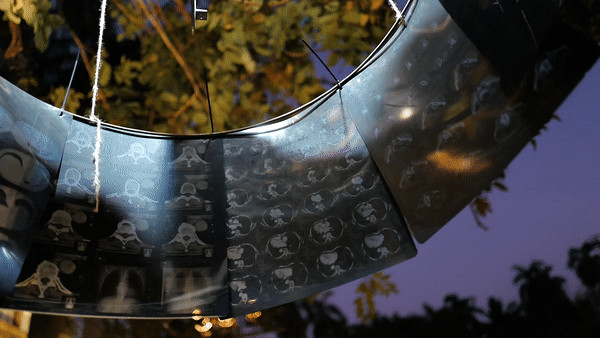
In the summer of 2004, I transported a ton of seawater from the mouth of the river Etsch to the Brenner Pass. The bunker of scalini 84 stufen was filled with a hundred plastic buckets of water. Another four buckets of the seawater were fastened to the steep stone wall between the waterfall and the bunker, forming a vertical line. In April 2007, the bunker was emptied, the buckets and iron brackets were dismantled and taken from the wall, while the remaining water (about 700 of the original 1,000 liters had evaporated) was taken back to the Etsch river mouth and restored to its place of origin.
A close inspection shows that every movement is circular and the Brenner Pass is a wonderful place to observe circularity: the tourists pass by on their way to the sea, where they will get a tan, then afterwards go home and become pale again. German milk arrives in Italy and is turned into Gorgonzola, then is sent back to Germany.
Even the water of the cascade scalini 84 stufen evaporates once it is returned to the sea, and then comes back to the mountain again in the form of rain. By collecting water at the mouth of the river Etsch and later returning it to its place of origin, I aimed to demonstrate the beginning, and also the end, of its eternal travel. As for the tourists, I predict they will get a tan and then de-tan again.
What remains for me, at the end of one work and the beginning of another, is the realization of an old dream: looking at the mountains and smelling the sea …
Two and a half years is a long period for an installation, but in reality this work took even longer. In 1987, I saw Peter Kaser’s work in the mine of Schneeberg; in 2001, I saw himmel & hoell by Lanthaler and Kaser; and then in 2002, Anschluss – coincidenza by Franz Pichler. In 2004, I was at the concert-installation by Jack Alemanno and in the meantime, I did more on-site inspections. And, for more than two years, I completed dozens of drawings.
It is only now that I begin to realize that the landscape of the mountain as well as the seascape cannot be explained (everyone is looking for a solution to this enigma on their own).
Maybe it has to be explored through the medium of art, to have the desire to understand the forms and volumes of the mountains, but also to have a sense of the autonomy of nature, for nature’s solitariness and magnitude.
More than three hundred years before the Romantic painters paid attention to it, Leonardo da Vinci had artistically explored this terrain in his drawings of mountain thunderstorms; to see them today, is to see extraordinary and incredible modern shorthand. He was the first to understand how the artist has to move in the Alpine landscape: wide awake, with fear, with respect, and with absolute confidence.
Apart from my colleagues who I met during these years in Brenner, I want to thank above all Peter Kaser, who dedicated a great deal of his time to me, and, I guess, all of his patience too.









